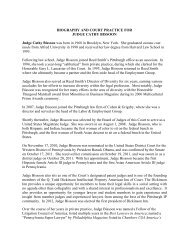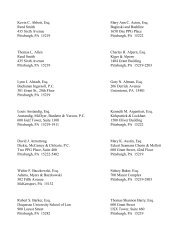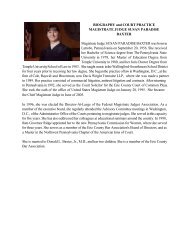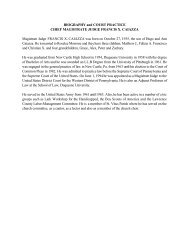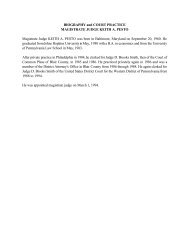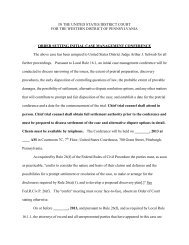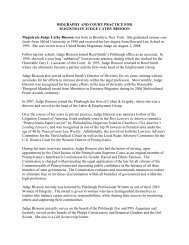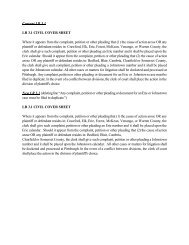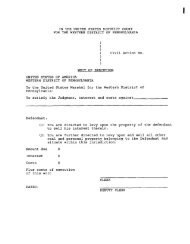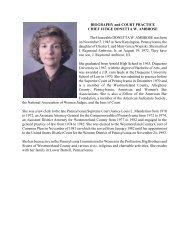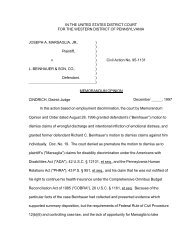preliminary general matters - Western District of Pennsylvania
preliminary general matters - Western District of Pennsylvania
preliminary general matters - Western District of Pennsylvania
You also want an ePaper? Increase the reach of your titles
YUMPU automatically turns print PDFs into web optimized ePapers that Google loves.
THE HONORABLE JOY FLOWERS CONTI<br />
U.S. DISTRICT COURT FOR THE WESTERN DISTRICT OF PENNSYLVANIA<br />
RULES FOR PRETRIAL AND TRIAL MATTERS<br />
PRELIMINARY GENERAL MATTERS<br />
1. Correspondence With the Court<br />
Correspondence with the Court is disfavored, except to advise the Court <strong>of</strong> the status <strong>of</strong><br />
something happening in the case, e.g., mediation. If a party desires Judge Conti to take<br />
some action, the party must file a motion. Judge Conti does not accept letter briefs.<br />
2. Communications With Law Clerks<br />
Parties may communicate with Judge Conti's law clerks about scheduling and other<br />
administrative <strong>matters</strong>. They are not to discuss any substantive legal matter with the law<br />
clerks.<br />
3. Telephone Conferences<br />
Although, <strong>general</strong>ly, Judge Conti prefers that the lawyers in a matter attend all<br />
conferences with the Court, she will allow attendance by telephone if counsel submits a<br />
request and there is a good reason to do so. She will suggest conferences by telephone<br />
when they are likely to be brief and a lawyer is from out-<strong>of</strong>-town.<br />
4. Oral Arguments and Evidentiary Hearings<br />
Judge Conti schedules oral argument on most substantive motions, particularly motions<br />
to dismiss. She, however, <strong>general</strong>ly does not schedule oral argument on motions<br />
summary judgment. If she can dispose <strong>of</strong> the motion on the record, she will do so.<br />
5. Pro Hac Vice Admissions<br />
Motions for a pro hac vice admission must be made in accordance with the local rules <strong>of</strong><br />
the <strong>Western</strong> <strong>District</strong>.
CIVIL CASES<br />
Pretrial Procedure<br />
1. Pretrial Conferences<br />
Judge Conti will hold at least four conferences prior to trial:<br />
A. An initial Rule 16 conference at which a schedule for all fact discovery will be<br />
set. The parties should also be prepared to discuss what issues they anticipate will<br />
arise in the case, as well as the prospects for settlement. This conference<br />
<strong>general</strong>ly lasts 10 - 30 minutes.<br />
B. A conference at the close <strong>of</strong> all fact discovery. The purpose <strong>of</strong> this conference is<br />
to ascertain whether all fact discovery is completed. If fact discovery is not<br />
completed, the parties should file a request to extend the date for completion <strong>of</strong><br />
fact discovery prior to the date <strong>of</strong> the scheduled conference. If fact discovery is<br />
completed, the Court will determine whether expert discovery will be required,<br />
and if it is, she will set dates for reports to be filed, expert discovery to be<br />
completed; objections to experts' testimony to be filed; and a presumptive date for<br />
a Daubert hearing. She will also determine if a summary judgment motion will be<br />
filed and if it will be, she will also set a briefing schedule, which will either run<br />
contemporaneously with expert discovery or, if expert discovery is required<br />
before the motion can be filed, after expert discovery is completed. If no<br />
summary judgment motion will be filed, Judge Conti will set a date for trial, as<br />
well as for the filing <strong>of</strong> various documents (pretrial statements, joint pretrial<br />
stipulation, motions in limine, proposed voir dire, jury instructions and verdict<br />
form) and a pretrial conference. Judge Conti will again broach the subject <strong>of</strong><br />
settlement at this conference.<br />
C. A pretrial conference at which Judge Conti will review with the parties her<br />
proposed jury voir dire and <strong>preliminary</strong> charge. She will also rule on motions in<br />
limine, unless they are so voluminous that she feels a separate conference is<br />
necessary to address them. By the time <strong>of</strong> this conference, Judge Conti will have<br />
reviewed the parties' pretrial submissions and will address with them any issues<br />
that have arisen in her mind related to them. Again, Judge Conti will discuss<br />
settlement with the parties.<br />
D. A conference on the date <strong>of</strong> jury selection. At this conference, Judge Conti and<br />
the parties will finalize voir dire and resolve all disputes over the <strong>preliminary</strong><br />
charge and exhibits. Settlement will not be discussed at this time as Judge Conti<br />
expects the parties to settle prior to the jury panel being brought in.<br />
Judge Conti may hold other conferences if necessary.<br />
2
2. Requests for Extensions and Continuances<br />
Parties seeking an extension or continuance must file a written motion, stating why they<br />
could not meet the deadlines set by the Court and, in the case <strong>of</strong> extensions <strong>of</strong> discovery,<br />
what discovery remains to be taken and how long it will take. The proposed order<br />
accompanying such motions shall include the date certain, or a blank space for insertion<br />
<strong>of</strong> the date certain, on which the proposed new deadline falls. If more than one deadline<br />
is affected by the requested extension, the proposed order shall include all such affected<br />
dates.<br />
Judge Conti may decide such motions without response because <strong>of</strong> the Court's inherent<br />
discretion over scheduling. Generally, she requires good cause to support a request for an<br />
extension <strong>of</strong> a deadline. She is more liberal in granting such motions early in a case and<br />
more stringent as the case advances and/or other extensions have been granted.<br />
3. General Motion Practice<br />
Judge Conti has set the following rules relating to motion practice before her:<br />
A. Form <strong>of</strong> Motions. A motion must consist <strong>of</strong> two documents, consisting <strong>of</strong> a<br />
motion stating the party's request and a separate brief containing the factual and<br />
legal grounds for the request. Evidentiary materials in support <strong>of</strong> or opposition to<br />
a motion should be tabbed and compiled in a separate document. If the<br />
evidentiary materials are voluminous, i.e., more than 25 pages, a courtesy copy <strong>of</strong><br />
the materials appropriately marked and tabbed should be furnished to the judge’s<br />
chambers. Only the evidentiary materials that are essential to deciding the motion<br />
should be submitted to the Court. A proposed order setting forth the specific<br />
relief requested must be attached to the motion.<br />
B. Form <strong>of</strong> Responses. The opposing party shall file a response to every motion.<br />
Unless otherwise directed, the response should be titled in the form <strong>of</strong> "A's<br />
Response to B's Motion [for/to] _____." A brief may be filed with the response<br />
as a separate document. A proposed order shall also be attached to the response.<br />
C. Routine or Unopposed Motions. If the nonmoving party does not oppose the<br />
motion, or the motion is <strong>of</strong> a type that normally does not implicate the substantial<br />
rights <strong>of</strong> the nonmoving party (e.g. motion to withdraw as counsel, motion to set a<br />
conference, many motions for extension <strong>of</strong> time), the nonmoving party shall so<br />
state in its response. The court may decide motions that do not implicate the<br />
substantial rights <strong>of</strong> the opposing party without a response, which relieves the<br />
nonmoving party <strong>of</strong> the duty to respond. Absent such action by the court,<br />
however, it is essential that a response be filed for all motions. Letters do not<br />
constitute responses on the record. Failure to respond may be deemed as consent<br />
to the motion.<br />
3
D. Deadlines for Responses.<br />
a. Responses to motions relating to discovery shall be filed 14 days from the<br />
date <strong>of</strong> service <strong>of</strong> the motion. The court frequently resolves such motions<br />
by telephone conference, which the parties may request and which the<br />
court also may schedule before any response is required. If a telephone<br />
conference is scheduled, the nonmoving party is excused from filing a<br />
response, and will state its position during the telephone conference.<br />
b. Responses to motions in limine shall be filed 7 days from the date <strong>of</strong><br />
service <strong>of</strong> the motion.<br />
c. Responses to motions for summary judgment shall be filed 30 days from<br />
the date <strong>of</strong> service <strong>of</strong> the motion.<br />
d. Responses to all other motions shall be filed 21 days from the date <strong>of</strong><br />
service <strong>of</strong> the motion.<br />
E. Joint Motions. Joint or uncontested motions on <strong>matters</strong> that do not implicate the<br />
substantial rights <strong>of</strong> the parties are encouraged and will be promptly decided. A<br />
joint or uncontested motion shall so state in its title. Joint motions in cases with<br />
more than two parties that have the consent <strong>of</strong> fewer than all the parties shall so<br />
state on the first page. Counsel's representation that a motion is joint or consented<br />
to is sufficient.<br />
F. Page Limits.<br />
a. Briefs in support <strong>of</strong> and opposing discovery motions shall be limited to 10<br />
pages.<br />
b. Briefs in support <strong>of</strong> and opposing motions in limine shall be limited to 5<br />
pages.<br />
c. Briefs in support <strong>of</strong> and opposing summary judgment motions shall be<br />
limited to 20 pages, excluding tables.<br />
(i)<br />
(ii)<br />
Every motion for summary judgment and supporting brief, if based<br />
on the affirmative pro<strong>of</strong> <strong>of</strong> facts, shall be accompanied by a<br />
statement <strong>of</strong> material facts not in dispute, which must be a separate<br />
document. This statement shall contain numbered paragraphs<br />
setting forth all the facts supporting the motion which are<br />
necessary for its resolution. Each factual assertion shall cite to<br />
evidentiary material accompanying the motion. The<br />
accompanying evidentiary material shall be limited to the amount<br />
necessary to support the motion.<br />
Every party opposing a motion for summary judgment shall file, in<br />
addition to its brief in opposition, a response to the moving party's<br />
4
statement <strong>of</strong> material facts not in dispute, which must be a separate<br />
document. In paragraphs corresponding to the statement <strong>of</strong><br />
material facts not in dispute, the opposing party shall state whether<br />
the facts listed are disputed. For any disputed fact, the opposing<br />
party shall cite to evidentiary material demonstrating the dispute,<br />
and attach such evidentiary material to its response.<br />
(iii)<br />
(iv)<br />
(v)<br />
Parties need not repeat the relevant facts in their briefs, but may do<br />
so for clarity.<br />
The argument portion <strong>of</strong> every brief in support <strong>of</strong> a motion for<br />
summary judgment shall, for each claim to be considered, set forth<br />
the elements <strong>of</strong> the claim and cite to current authority for the Court<br />
<strong>of</strong> Appeals for the Third Circuit, if available, that establishes the<br />
essential elements <strong>of</strong> each claim for which the moving party seeks<br />
summary judgment.<br />
A party's failure to adhere to these requirements may result in the<br />
motion for summary judgment being decided against that party's<br />
position.<br />
d. Briefs in support <strong>of</strong> and opposing all other motions shall be limited to 15<br />
pages.<br />
e. All text and footnotes in briefs shall be in 12 point fonts, with one inch<br />
margins. Text must be double-spaced; footnotes may be single-spaced.<br />
Evasion <strong>of</strong> these standards or page limits will cause the brief to be stricken<br />
from the record or the excess material to be treated as being outside the<br />
record without further notice to counsel.<br />
f. Counsel and the parties should be aware <strong>of</strong> the court's experience that<br />
shorter briefs are almost always more persuasive because they get to the<br />
point faster. They also contain less extraneous material that dilutes the<br />
parties' main arguments, and frequently interferes with prompt resolution.<br />
4. Reply Briefs and Surreply Briefs<br />
Except for summary judgment motions, the Court discourages reply briefs because<br />
usually repetitive and, therefore, wasteful. They may be filed only upon leave <strong>of</strong> Court.<br />
Reply briefs should state the novel matter contained in the opposition brief that merits a<br />
reply and not merely assert that opposing counsel has misstated the law.<br />
If allowed, reply briefs are limited to 10 pages unless otherwise ordered by the Court.<br />
Surreply briefs will be allowed only upon leave <strong>of</strong> Court, should state the novel issue and<br />
not reargue issues already addressed. A surreply brief is limited to 10 pages unless<br />
otherwise ordered by the Court.<br />
5
5. Chambers' Copies <strong>of</strong> Motion Papers; Courtesy Copies<br />
Except for voluminous materials, i.e., in excess <strong>of</strong> 25 pages, counsel should not submit<br />
courtesy copies unless requested by the Court. Voluminous materials should be<br />
appropriately marked and tabbed prior to submission to the Court.<br />
Discovery Matters<br />
1. Length <strong>of</strong> Discovery Period and Extensions<br />
Unless counsel for the parties jointly agree that they require a longer period for discovery<br />
and have reasons supporting their request, Judge Conti is inclined to set a 90 to 120 day<br />
discovery period. If she allows a longer period, she will advise counsel that they must<br />
meet their deadlines, not expect an extension, and, therefore, should schedule depositions<br />
early in the period.<br />
2. Discovery Conferences<br />
Judge Conti expects the parties to be able to resolve discovery issues themselves. If they<br />
cannot, she will resolve discovery disputes that do not require her to review written<br />
discovery responses or to issue a written order over the telephone. Otherwise, the parties<br />
must file a written motion and appear before her in person.<br />
If Judge Conti is available, she will accept telephone calls from counsel in a deposition in<br />
order to resolve a dispute.<br />
3. Confidentiality Agreements<br />
All confidentiality agreements must meet the requirements <strong>of</strong> the local rules. If such<br />
agreements meet these requirements and the parties agree on their contents, Judge Conti<br />
will sign them.<br />
4. Expert Witnesses<br />
Judge Conti <strong>general</strong>ly schedules expert discovery and the date for a Daubert hearing, if<br />
necessary, after fact discovery. Although if the parties desire to take expert discovery<br />
earlier, she will allow it.<br />
1. General Approach<br />
Settlement<br />
Judge Conti will discuss settlement in cases which will be tried to a jury. In nonjury<br />
<strong>matters</strong>, she will discuss settlement only if the matter is particularly complex and all<br />
parties consent to her participation. Otherwise, she will refer settlement discussions to a<br />
6
a lawyer listed on the <strong>Western</strong> <strong>District</strong>'s ADR panel, or the parties may select a private<br />
mediator. Judge Conti will not entertain settlement discussions if a dispositive motion is<br />
pending before the Court.<br />
Proposed Final Pretrial Memoranda<br />
1. Required Form <strong>of</strong> Pretrial Memoranda<br />
Judge Conti follows Local Rule 16.1.C with regard to pretrial statements.<br />
1. Scheduling and Expedited Discovery<br />
Injunctions<br />
Judge Conti will schedule an expedited hearing, when required, on requests for injunctive<br />
relief. She rarely issues temporary restraining orders without both parties present. If she<br />
is not available, motions for a temporary restraining order will be heard by the<br />
miscellaneous judge.<br />
The Court will hear argument on requests for expedited discovery and will order it if<br />
warranted.<br />
2. Proposed Findings <strong>of</strong> Fact and Conclusions <strong>of</strong> Law<br />
Proposed findings <strong>of</strong> fact and conclusions <strong>of</strong> law are required in any matter to be decided<br />
by the Court. If, however, emergency injunctive relief is sought, Judge Conti will rule<br />
from the bench, without proposed findings <strong>of</strong> fact and conclusions <strong>of</strong> law.<br />
1. General Approach<br />
Trial Procedure<br />
Counsel should be on time for each court session. When the court recesses, attorneys and<br />
their support personnel must stay in place until the jury has left the courtroom.<br />
2. Scheduling <strong>of</strong> Cases<br />
Court is normally in session Monday through Thursday, 9:30 a.m. to 4:30 p.m. with<br />
breaks at approximately 11:00 a.m. and 3:00 p.m. Fridays, unless otherwise ordered by<br />
the Court, are reserved for pretrial and status conferences, sentencing and evidentiary<br />
hearings. Counsel must be available at 9:00 a.m. and 4:30 p.m. on days the court is in<br />
session to meet with the court concerning scheduling, trial problems, and to obtain<br />
advance rulings on evidentiary or other issues.<br />
7
3. Conflict <strong>of</strong> Counsel<br />
Trial is to take precedence over other <strong>matters</strong>. Judge Conti expects counsel to file<br />
motions in other courtrooms to accommodate trial. With adequate advance notice, she<br />
will, if possible, schedule trial to take into account other scheduled trials and court<br />
proceedings as well as planned vacations.<br />
4. Cases Involving Out-<strong>of</strong>-Town Parties or Witnesses<br />
The Court will take into account out-<strong>of</strong>-town parties and witnesses in the scheduling <strong>of</strong> a<br />
trial. She will also allow such witnesses to testify remotely and out <strong>of</strong> turn.<br />
5. Notetaking by Jurors<br />
Jurors are permitted to take notes.<br />
6. Trial Briefs<br />
Trial briefs are <strong>general</strong>ly not required as all issues are typically resolved prior to trial.<br />
Judge Conti will ask for trial briefs on <strong>matters</strong> prior to or during trial if she deems them<br />
necessary.<br />
7. Voir Dire<br />
Voir dire in civil cases is conducted by either Judge Conti's courtroom deputy or law<br />
clerk. Counsel may not address potential jurors. Judge Conti will resolve all challenges<br />
for cause and will conduct individual voir dire in her jury room when necessary. In civil<br />
cases the court reporter does not attend voir dire, but will be asked to record challenges<br />
for cause.<br />
8. Objections; Side Bars<br />
A. When counsel makes objections, the objection must be stated. In the presence <strong>of</strong><br />
the jury, counsel should not state the legal basis for the objection or make any<br />
further argument concerning the objection. Counsel should not argue with the<br />
ruling <strong>of</strong> the Court on the objection. Arguments with respect to objections will<br />
<strong>general</strong>ly be heard at the 4:30 p.m. conference with the court, or at side bar.<br />
B. Side bars are highly disfavored because they waste the jury's time and unduly<br />
extend the length <strong>of</strong> the trial. Counsel are required to file motions in limine<br />
together with supporting briefs no later than the date scheduled by the Court or, if<br />
not scheduled, at least one week in advance <strong>of</strong> trial with regard to evidentiary<br />
<strong>matters</strong>. Counsel will meet with the court at 4:30 p.m. each day to raise points <strong>of</strong><br />
evidence or other issues that would otherwise necessitate a side bar. Failure to<br />
raise issues at the beginning or end <strong>of</strong> the trial day will <strong>general</strong>ly result in a<br />
disposition <strong>of</strong> the in-court objection in the presence <strong>of</strong> the jury.<br />
8
C. There should be no requests for <strong>of</strong>fers <strong>of</strong> pro<strong>of</strong> during trial as the parties will have<br />
discussed the next day's witnesses with each other or at the 4:30 p.m. conference<br />
with the court.<br />
9. In Limine Motions<br />
Counsel are required to file motions in limine together with supporting briefs no later<br />
than the date scheduled by the Court or, if not scheduled, at least one week in advance <strong>of</strong><br />
trial with regard to evidentiary <strong>matters</strong>.<br />
10. Opening Statements and Summations<br />
In the counsel's opening statement to the jury, which shall not exceed one hour for each<br />
side unless prior leave <strong>of</strong> Court is obtained, counsel should not argue the case or discuss<br />
law. Co-counsel are not permitted to split up the opening statement. Counsel should<br />
confine himself or herself to a concise summary <strong>of</strong> the important facts which counsel<br />
intends to prove. Counsel should not describe in detail what particular witnesses will say.<br />
With advance notice and approval <strong>of</strong> the Court, visual aids and exhibits may be used<br />
during opening statements.<br />
The Court will charge the jury prior to closing arguments. In a counsel's final, closing<br />
argument, counsel may quote the charge verbatim on a particular subject. Closing<br />
argument for each side shall not exceed one hour unless prior leave <strong>of</strong> Court is obtained.<br />
Co-counsel are not permitted to split up closing arguments. After the closing arguments,<br />
the Court will instruct the jury about the process <strong>of</strong> jury deliberations.<br />
11. Examination <strong>of</strong> Witnesses Out <strong>of</strong> Sequence<br />
Where appropriate, witnesses may be examined out <strong>of</strong> sequence upon request <strong>of</strong> a party.<br />
Witnesses may be examined in any order to which counsel agrees. For example, counsel<br />
could agree that expert witnesses for each side will testify back to back.<br />
12. Examination <strong>of</strong> Witnesses<br />
A. Counsel should not greet or introduce himself or herself to witnesses.<br />
Examination should be commenced without preliminaries.<br />
B. Witnesses should not be addressed on a first name basis. Witnesses should be<br />
referred to by Mr. or Ms. Pr<strong>of</strong>essional witnesses should be referred to by their<br />
appropriate title, i.e., doctor, pr<strong>of</strong>essor, etc.<br />
C. Counsel should not pace about the courtroom when questioning witnesses. This<br />
conduct distracts the jury and wastes time. Counsel may take any position in<br />
which they are comfortable, sitting or standing, when questioning witnesses,<br />
provided that the other counsel’s ability to view the witness and the jury is not<br />
obstructed.<br />
9
D. Each witness may be examined and cross-examined by only one attorney<br />
representing each party. That attorney will also make all objections and speak for<br />
his or her client at all side bar conferences.<br />
E. The court limits examination <strong>of</strong> each witness to direct examination, crossexamination,<br />
redirect examination, and recross-examination. That means that<br />
each party may question a witness only twice.<br />
F. Counsel may approach witnesses without leave <strong>of</strong> Court for purposes <strong>of</strong><br />
identifying and interrogating concerning exhibits.<br />
G. Counsel should not face or otherwise appear to address himself or herself to jurors<br />
when questioning a witness.<br />
H. Counsel shall not approach the jury without leave <strong>of</strong> Court and should not lean or<br />
place papers on the jury box.<br />
13. Examination <strong>of</strong> Witnesses Beyond Direct or Cross<br />
The Court will allow re-direct and re-cross.<br />
14. Videotaped Testimony<br />
The Court requires all parties to retain a competent video operator for any video to be<br />
shown during trial.<br />
15. Reading <strong>of</strong> Material Into the Record<br />
Counsel can devise their own methodology for reading material into the record, providing<br />
opposing counsel agrees.<br />
16. Preparation <strong>of</strong> Exhibits<br />
A. Counsel shall mark and exchange all exhibits prior to trial. Plaintiffs shall use<br />
numbers and Defendants shall use letters. The parties shall compare exhibits and<br />
eliminate duplicates. If more than one party wants to <strong>of</strong>fer the same exhibit it<br />
shall be marked with a number and listed as a joint exhibit on the parties' exhibit<br />
lists. Two weeks prior to trial, each party shall supply the Court with a copy <strong>of</strong> all<br />
exhibits to be used at trial and must identify whether an exhibit’s authenticity and<br />
admissibility have been agreed to by opposing counsel or are in dispute. The<br />
Court will resolve disputes prior to trial if possible. The parties shall supply the<br />
courtroom deputy/law clerk with a second set <strong>of</strong> exhibits to be used as part <strong>of</strong> the<br />
<strong>of</strong>ficial records <strong>of</strong> the Court.<br />
B. In advance <strong>of</strong> each trial session, counsel for the party going forward at that<br />
session should show opposing counsel the exhibits he or she intends to introduce<br />
at the session.<br />
10
C. All exhibits already admitted into evidence that are not electronically stored must<br />
remain on the table immediately in front <strong>of</strong> the bench at all times, except when<br />
being used as part <strong>of</strong> the examination <strong>of</strong> a witness. Do not take exhibits to<br />
counsel table.<br />
D. If counsel intends to question a witness about any document or exhibit, all such<br />
documents or exhibits that are not electronically stored and that will be used<br />
during the examination <strong>of</strong> that witness should be placed at the witness stand prior<br />
to the commencement <strong>of</strong> direct examination or cross-examination.<br />
E. At the conclusion <strong>of</strong> direct or cross-examination <strong>of</strong> a witness, counsel should<br />
return all exhibits that are not electronically stored and which have been admitted<br />
into evidence to the exhibit table.<br />
17. Offering Exhibits Into Evidence<br />
If the parties agree on the admission <strong>of</strong> an exhibit, the party <strong>of</strong>fering it does not need to<br />
move its admission. If they do not agree, the party <strong>of</strong>fering it must move to have it<br />
admitted if possible, at a pretrial conference or at side bar. The exhibit must be admitted<br />
before any questioning can proceed.<br />
18. Motions for Judgment as a Matter <strong>of</strong> Law and Motions for Judgment on Partial<br />
Findings.<br />
The only requirements for such motions are set forth in the Federal Rules <strong>of</strong> Civil<br />
Procedure and in the Order on Motion Practice entered in the case.<br />
19. Proposed Jury Instructions and Verdict Forms<br />
The parties shall file a joint set <strong>of</strong> proposed jury instructions pursuant to the following<br />
procedure:<br />
The parties shall meet in an attempt to agree on a joint set <strong>of</strong> proposed jury instructions.<br />
After their meeting, the parties shall file one document containing a combined set <strong>of</strong><br />
proposed instructions which includes both agreed upon instructions and proposed<br />
instructions to which the parties have not agreed. Each agreed upon instruction shall<br />
include the following notation at the bottom: "This proposed instruction is agreed upon<br />
by the parties." Each instruction to which the parties have not agreed shall indicate at the<br />
bottom the name <strong>of</strong> the party pr<strong>of</strong>fering the instruction. Proposed instructions by<br />
different parties shall be grouped together. The court will not accept separate proposed<br />
jury instructions from the parties.<br />
20. Proposed Findings <strong>of</strong> Fact and Conclusions <strong>of</strong> Law<br />
Judge Conti requires proposed findings <strong>of</strong> fact and conclusions <strong>of</strong> law in all bench trials.<br />
11
21. Conference on Proposed Jury Instructions<br />
Judge Conti holds her charge conference on a rolling basis, beginning with the pretrial<br />
conference and continuing in the conference she holds before the jury is selected and trial<br />
begins. She will accept, throughout the trial, supplemental jury instructions and<br />
objections to the extent the issues raised could not have been anticipated prior to trial.<br />
Judge Conti will make her final rulings before instructing the jury prior to closing<br />
arguments.<br />
1. Written Jury Instructions<br />
Jury Deliberations<br />
Jurors are provided with a copy <strong>of</strong> both the <strong>preliminary</strong> charge and the final charge which<br />
they take with them to the jury room.<br />
2. Exhibits in the Jury Room<br />
Generally, the jury has with it all exhibits during its deliberations. If an exhibit is in<br />
electronic form, the parties should make available to the jury the hardware and s<strong>of</strong>tware<br />
necessary to view the exhibit.<br />
3. Handling <strong>of</strong> Jury Requests to Read Back Testimony or Replay Tapes<br />
Jury requests to read back testimony or replay tapes during deliberations are permitted<br />
when the jury is able to point to a specific portion <strong>of</strong> the testimony or videotape.<br />
4. Questions from Jury<br />
All written questions submitted by the jury are supplied to counsel. Counsel and the<br />
Court meet in chambers to discuss and hopefully to agree on a reply. The response in<br />
written form will be sent to the jury or in certain circumstances the jury may be<br />
summoned to the courtroom and a verbal reply is given to them.<br />
5. Availability <strong>of</strong> Counsel During Jury Deliberations<br />
Trial counsel need not remain in the courtroom area, but must be available by telephone<br />
and able to return to the courtroom within about five minutes.<br />
6. Taking the Verdict and Special Interrogatories<br />
The bailiff will retrieve from the jury foreperson the verdict and/or responses to special<br />
interrogatories and give it to the Court. After the Court reviews it, the bailiff will read<br />
the verdict.<br />
12
7. Polling the Jury<br />
Judge Conti <strong>general</strong>ly polls the jury.<br />
8. Counsel Interviewing the Jury<br />
Interviewing jurors post-verdict is discouraged. Judge Conti tells the jurors that it is up to<br />
them to decide if they will speak to counsel.<br />
1. Oral Argument and Motions<br />
CRIMINAL CASES<br />
Motions must be in writing. Judge Conti will <strong>general</strong>ly schedule oral argument.<br />
2. Pretrial Conferences<br />
Judge Conti conducts a pretrial conference in criminal cases. The parties are to submit<br />
proposed voir dire and jury instructions prior to the conference. Unlike in civil cases, the<br />
parties are not required to submit joint instructions. Judge Conti will have a draft <strong>of</strong> voir<br />
dire and her <strong>preliminary</strong> charge to the jury for distribution at the conference. She will<br />
hold a second conference one or two days prior to a criminal trial at which she will<br />
decide on final voir dire and her <strong>preliminary</strong> charge.<br />
3. Voir Dire<br />
Judge Conti will conduct voir dire on the record in criminal cases.<br />
4. Conduct <strong>of</strong> Trial Differing From Civil to Criminal<br />
Judge Conti conducts criminal trials similarly to civil trials. The parties, however, do not<br />
submit joint jury instructions and voir dire and do not exchange witness lists and exhibits<br />
until the first day <strong>of</strong> trial.<br />
5. Sentencing Memoranda<br />
Judge Conti requires the submission <strong>of</strong> sentencing memoranda in accordance with the<br />
local rules. Objections to the report <strong>of</strong> the pre-sentence investigation will be resolved at<br />
the sentencing. Judge Conti <strong>general</strong>ly issues tentative findings with respect to applicable<br />
advisory guidelines range a day prior to the sentencing.<br />
13



